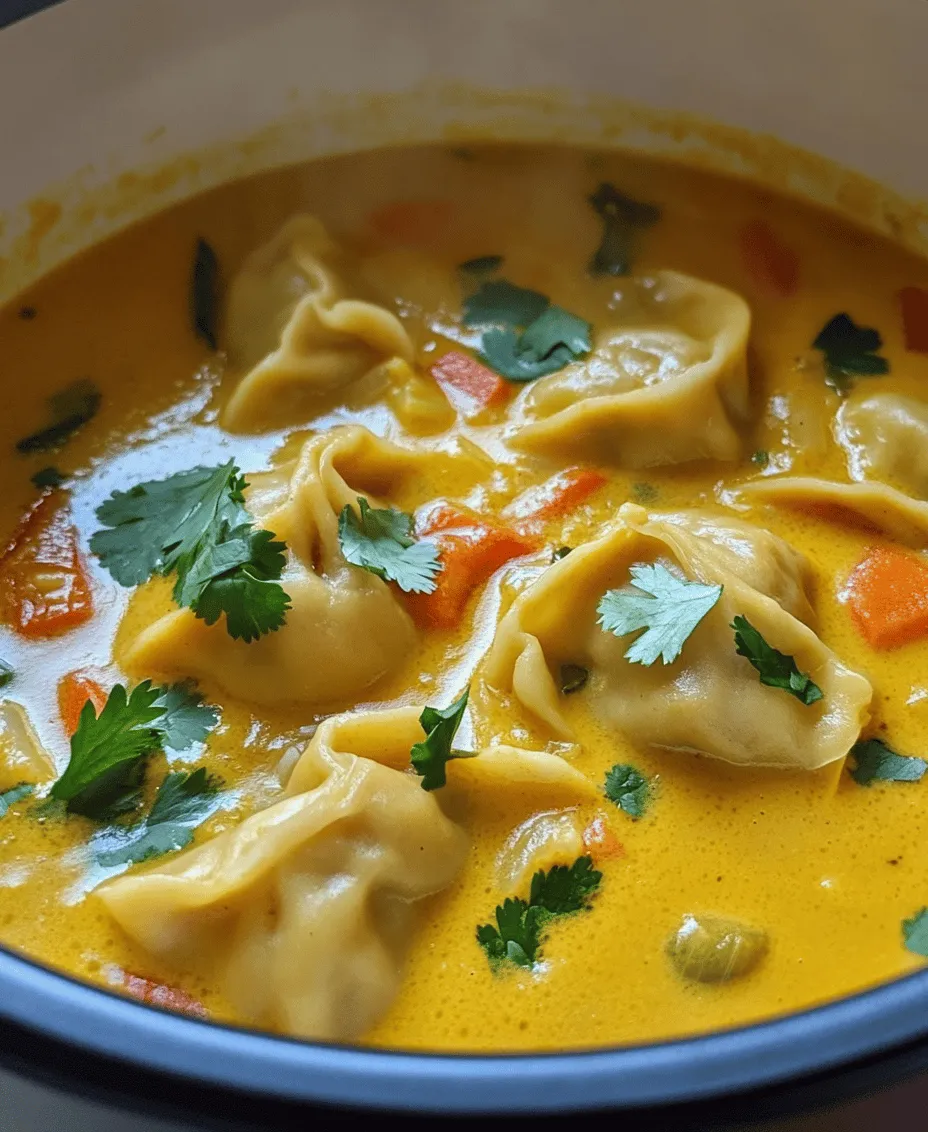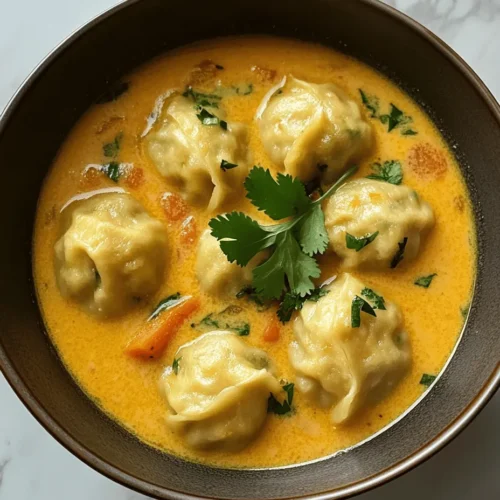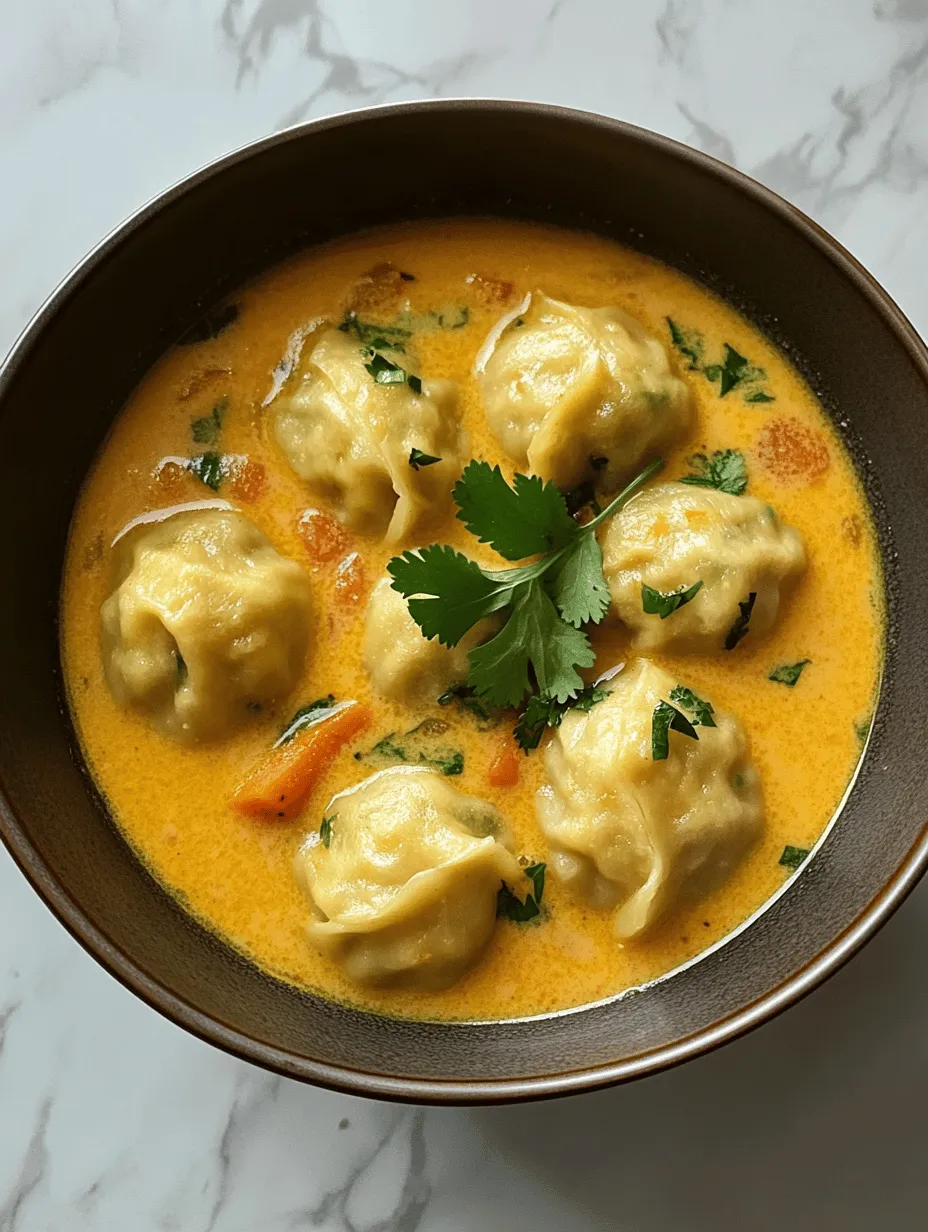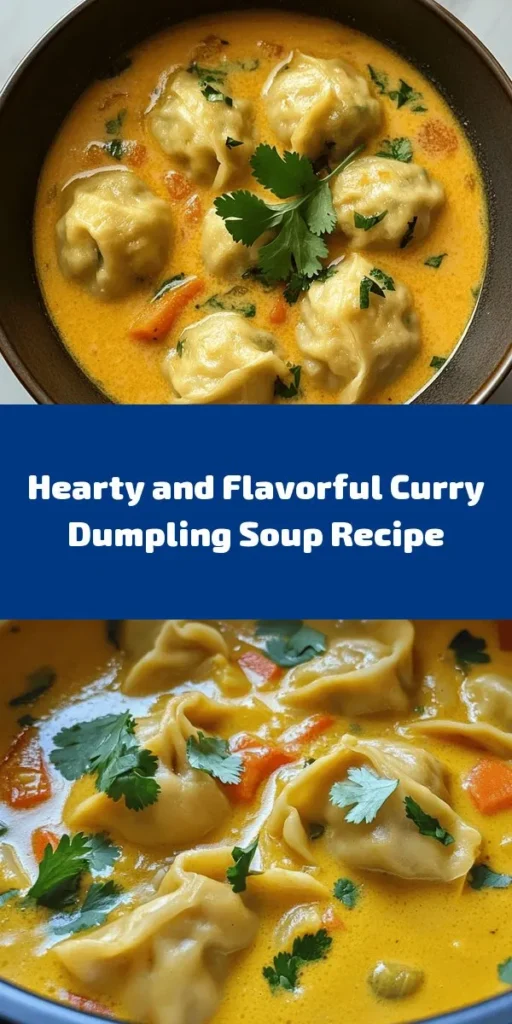Introduction
Soup recipes have long been cherished for their comforting qualities and ability to warm both body and soul. Among the diverse world of soups, dumpling soup holds a special place, celebrated not just for its heartiness but also for the variety it offers across different cuisines. Across cultures, dumpling soup signifies comfort, family gatherings, and home-cooked warmth. Whether it’s the beloved Asian bao, Italian gnocchi, or Eastern European pierogi, dumplings have the power to bring people together and evoke nostalgia.
In this article, we delve into the Best Curry Dumpling Soup, a dish that brilliantly combines the artistry of dumpling making with the warmth of a fragrant curry broth. This recipe stands out with its unique blend of spices and ingredients, delivering a rich tapestry of flavors while offering numerous health benefits. The soup is not only a treat for the taste buds, but its vegetarian-friendly ingredients make it an excellent choice for those following a plant-based diet or simply looking to incorporate more vegetables into their meals.
Understanding the Ingredients
When crafting the Best Curry Dumpling Soup, the quality and selection of ingredients are paramount. Each component plays a vital role in building flavor, texture, and nutritional value. Let’s take a closer look at the essential ingredients used in both the dumplings and the curry soup.
Dumpling Ingredients
1. All-Purpose Flour: This is the backbone of the dumpling dough. Its gluten content helps create the desired structure, providing a chewy yet tender texture. For those seeking gluten-free options, alternative flours such as rice flour or a gluten-free blend can be used, though results may vary.
2. Water: Essential for achieving the right consistency in the dough, water hydrates the flour and activates gluten, allowing the dumplings to hold their shape during cooking. The temperature of the water can affect the dough’s elasticity; warm water tends to yield a softer texture.
3. Spices:
– Salt: A fundamental seasoning that enhances the overall flavor of the dumplings.
– Turmeric: Known for its vibrant yellow color and earthy flavor, turmeric also offers anti-inflammatory properties and can boost the immune system.
– Cumin: This spice adds a warm, nutty flavor to the dumplings while also providing digestive benefits.
4. Vegetables:
– Carrots: Adding sweetness and crunch, carrots are rich in beta-carotene, which is beneficial for eye health.
– Cabbage: With its mild flavor and crunchy texture, cabbage is a great source of vitamins K and C, as well as fiber.
– Bell Peppers: These colorful vegetables introduce a sweet and slightly tangy flavor, along with a wealth of vitamins A and C.
5. Chickpeas: A fantastic source of plant-based protein and fiber, chickpeas help bind the dumpling filling while contributing a nutty taste and creamy texture.
Curry Soup Ingredients
The soup base is what elevates this dish to a new level of comfort and flavor. Here’s a breakdown of the key ingredients in the curry soup:
1. Coconut Oil: Using coconut oil not only adds a subtle sweetness to the flavor profile but also offers health benefits. Rich in medium-chain triglycerides (MCTs), coconut oil can provide quick energy and support metabolism.
2. Aromatics:
– Onion: A staple in many dishes, onions add depth of flavor and sweetness when sautéed.
– Garlic: Renowned for its robust flavor and health benefits, garlic can enhance the immune system while also acting as a natural antibacterial agent.
– Ginger: This aromatic root adds a distinct warmth and spice, known for its digestive properties and anti-inflammatory effects.
3. Spices:
– Curry Powder: A blend of spices that brings warmth and complexity to the soup, curry powder often includes turmeric, coriander, cumin, and chili, each contributing unique flavors and health benefits.
– Ground Coriander: This spice imparts a citrusy, nutty flavor, complementing the curry powder and enriching the overall taste.
– Ground Cumin: Similar to its role in the dumplings, cumin enhances the soup’s warmth with its earthy flavor.
4. Vegetable Broth and Coconut Milk: These two ingredients form the creamy, rich base of the curry soup. Vegetable broth provides a savory depth, while coconut milk adds creaminess and a hint of sweetness, balancing the spices beautifully.
5. Greens: Incorporating leafy greens like spinach or kale not only boosts the soup’s nutritional profile but also adds vibrant color and texture. They are rich in vitamins and minerals, making this soup a wholesome option.
Step-by-Step Guide to Making Curry Dumpling Soup
Making the Dumpling Dough
Creating the perfect dumpling dough is the first step towards a delightful curry dumpling soup. Follow these instructions to achieve the right texture and consistency:
1. Mixing the Dough: In a large mixing bowl, combine 2 cups of all-purpose flour and 1/2 teaspoon of salt. Gradually add about 3/4 cup of warm water, mixing with a fork or your hands until a shaggy dough forms. The key here is to add water little by little to avoid a sticky mess.
2. Kneading: Transfer the dough onto a lightly floured surface. Knead the dough for about 5-7 minutes until it becomes smooth and elastic. It should not stick to your hands; if it does, sprinkle a little more flour. Proper kneading is crucial for developing gluten, which gives the dumplings their structure.
3. Resting the Dough: Once kneaded, wrap the dough in a clean kitchen towel or plastic wrap and let it rest for at least 30 minutes. This resting period allows the gluten to relax, making it easier to roll out later.
Preparing the Dumpling Filling
While the dough rests, it’s time to prepare the filling that will bring flavor and nutrition to your dumplings.
1. Mixing the Filling: In a large bowl, combine 1 cup of finely chopped carrots, 1 cup of shredded cabbage, 1/2 cup of diced bell peppers, and 1 cup of cooked and mashed chickpeas. Season with 1 teaspoon of turmeric, 1 teaspoon of cumin, and salt to taste. Mix well until all ingredients are evenly coated with the spices.
2. Vegetable Variations: Feel free to customize the filling based on what’s in season or your personal preferences. Other great options include zucchini, mushrooms, or scallions, all of which can add unique flavors and nutrients.
3. Chilling the Filling: For the best texture, refrigerate the filling for about 15 minutes before assembling the dumplings. Chilling helps the mixture firm up, making it easier to handle.
Shaping the Dumplings
Once your dough has rested and the filling is ready, it’s time to shape the dumplings.
1. Rolling Out the Dough: Divide the rested dough into four equal portions. Take one portion and keep the others covered to prevent them from drying out. Roll out the dough on a lightly floured surface until it’s about 1/8 inch thick.
2. Cutting the Wrappers: Using a round cutter or a glass, cut out circles from the rolled dough, approximately 3 inches in diameter. Gather the scraps, re-knead, and roll out again to cut more wrappers.
3. Filling the Dumplings: Place about 1 tablespoon of the vegetable filling in the center of each dough circle. Be careful not to overfill, as it can cause the dumplings to burst during cooking.
4. Sealing the Dumplings: Moisten the edges of the dough circle with a little water. Fold the dough over the filling to create a half-moon shape and press the edges firmly to seal. Ensure no air is trapped inside, as this could cause them to open while cooking.
5. Resting the Dumplings: Place the shaped dumplings on a floured baking sheet and cover them with a damp cloth while you prepare the soup. This prevents them from drying out.
With the dumplings prepared, you are well on your way to creating a comforting bowl of Best Curry Dumpling Soup. In the next part of this article, we will explore how to create the rich and flavorful curry broth that will bring everything together in perfect harmony. Stay tuned for the next steps that will guide you to complete this delicious recipe!

Techniques for Rolling and Folding Dumplings
Creating the perfect dumpling is an art that combines skill and technique. The first step in this process is preparing the dough, which should be soft and pliable yet firm enough to hold its shape. When rolling out the dough, aim for a thickness of about 1/16 inch; this ensures that your dumplings will be tender yet sturdy.
Rolling the Dough
1. Divide the Dough: Start by dividing your dough into smaller portions. This makes it easier to handle.
2. Flour the Surface: Lightly dust your work surface and rolling pin with flour to prevent sticking.
3. Roll Evenly: Roll the dough into a circular shape, ensuring it is even throughout. If necessary, rotate the dough as you roll to maintain a round shape.
Folding the Dumplings
Once you have rolled out the dough, it’s time to fill and fold the dumplings.
1. Cut into Circles: Use a round cutter or a glass to cut perfect circles from the rolled dough. Aim for a diameter of about three inches.
2. Add Filling: Place a spoonful of your prepared filling in the center of each circle.
3. Seal the Edges: To fold, bring the edges of the dough together over the filling, pinching them firmly to seal. You can create pleats by folding and pinching the edges for a decorative touch. Sealing the edges properly is crucial to prevent the filling from leaking during the cooking process.
Making the Curry Soup
The soup is where the magic of flavor begins. A well-balanced curry soup enhances the dumplings and creates a comforting dish that warms the soul.
Step-by-Step Instructions for Sautéing Aromatics and Spices
1. Heat the Oil: In a large pot, heat a tablespoon of cooking oil over medium heat.
2. Sauté Aromatics: Add chopped onions, garlic, and ginger to the pot. Sauté for about 3-4 minutes until the onions become translucent and fragrant.
3. Add Spices: Stir in your choice of spices—curry powder, turmeric, and cumin work beautifully together. Sauté the spices for an additional minute, allowing them to release their essential oils and deepen in flavor.
Tips for Enhancing the Depth of Flavor During Cooking
– Use Fresh Ingredients: Fresh herbs and spices will yield a more vibrant taste compared to dried versions.
– Incorporate Aromatics Gradually: Add ingredients like lemongrass or chili peppers later in the sautéing process to maintain their integrity and flavor profiles.
– Deglaze the Pot: After sautéing, consider adding a splash of broth or water to the pot and scraping the bottom to release any browned bits. This adds a rich depth of flavor to your soup.
Combining and Simmering the Soup
Once your aromatics and spices are sautéed, it’s time to bring the soup together.
Guidelines for Adding Broth and Coconut Milk
1. Pour in Broth: Gradually add vegetable or chicken broth, stirring as you go.
2. Add Coconut Milk: Once the broth is heated through, stir in a can of coconut milk for creaminess. This also balances the spices with a sweet, rich flavor.
Techniques for Ensuring a Perfect Simmer Without Overcooking
– Watch the Heat: Bring the soup to a gentle simmer rather than a vigorous boil. A simmer allows flavors to meld without the risk of overcooking the ingredients.
– Timing is Key: Allow the soup to simmer for about 10-15 minutes, so the flavors develop without sacrificing the freshness of the vegetables.
Cooking the Dumplings
Now that your soup is aromatic and flavorful, it’s time to cook the dumplings.
Best Practices for Adding Dumplings to the Soup
1. Gentle Addition: Carefully place the dumplings into the simmering soup one by one, ensuring they don’t stick together.
2. Avoid Overcrowding: Depending on the size of your pot, you may need to cook dumplings in batches to avoid overcrowding, which can lead to uneven cooking.
Signs of Doneness and Tips for Avoiding Overcooking
– Watch for Floating: Dumplings are typically done when they float to the surface of the soup, indicating they are cooked through.
– Check Texture: Use a slotted spoon to pull one dumpling out and cut it in half. If the center is no longer doughy and feels firm, they are done. Ideally, dumplings should be tender yet chewy.
Finishing the Soup
To elevate your curry dumpling soup to the next level, finishing touches are essential.
Final Adjustments with Greens and Seasoning
1. Add Greens: Stir in fresh spinach, bok choy, or any leafy greens of your choice just before serving. This adds color and nutrition while ensuring they retain their vibrant texture.
2. Seasoning Check: Taste the soup and adjust the seasoning with salt, pepper, or a dash of lime juice to brighten the flavors.
Importance of Garnishing for Presentation and Taste
– Garnish Ideas: Fresh cilantro, green onions, or a sprinkle of chili flakes not only enhance presentation but also add layers of flavor.
– Serving: Serve the soup piping hot in bowls, garnished with your chosen toppings. This presentation invites everyone to dig in.
Nutritional Benefits of Curry Dumpling Soup
This delicious curry dumpling soup is not only a feast for the senses but also packed with health benefits.
Overview of the Health Benefits Associated with the Ingredients
– Vegetables: The variety of vegetables used in the soup contributes essential vitamins and minerals, promoting overall health.
– Legumes: If you include legumes in your dumpling filling, they provide a good source of protein and fiber.
Discussion on the Role of Spices in Digestion and Anti-Inflammatory Properties
– Spices like Turmeric: Known for its anti-inflammatory properties, turmeric can aid in digestion and boost immunity.
– Ginger and Garlic: Both are renowned for their ability to support digestive health and enhance immunity through their antibacterial properties.
Benefits of Consuming Vegetables and Legumes in a Balanced Diet
Incorporating a variety of vegetables and legumes into your diet supports overall health and wellness. They provide dietary fiber, which is essential for digestive health, and a range of antioxidants that combat oxidative stress.
Explanation of How the Soup Fits into a Healthy Meal Plan
The curry dumpling soup can serve as a wholesome meal on its own or as part of a larger family dinner. It’s a versatile dish that can be tailored to fit various dietary needs while remaining satisfying and nourishing.
Cultural and Culinary Significance of Dumpling Soups
Dumpling soups are a cherished dish across the globe, each culture adding its unique twist.
Brief History of Dumpling Soups Across Different Cultures
From the beloved Chinese wonton soup to the hearty Polish pierogi served in broth, dumpling soups have been a source of comfort and nourishment for centuries. Each region adapts its dumplings based on local ingredients and culinary traditions.
Exploration of Variations Found in Asian, Eastern European, and Other Cuisines
– Asian Variants: Many Asian cuisines feature dumplings served in broth, such as Japanese gyoza, Korean mandu, and Vietnamese bánh bao.
– Eastern European Influence: In Eastern Europe, dumplings like Polish pierogi are often served in savory or sweet soups, showcasing the versatility of this dish.
Reflection on How This Recipe Honors Traditional Flavors While Offering a Modern Twist
This recipe pays homage to traditional dumpling soups while incorporating a rich curry flavor, enhancing the dish’s appeal to modern palates. It celebrates cultural heritage while inviting innovation.
Conclusion
Making and enjoying the best curry dumpling soup is a delightful culinary experience that brings warmth and comfort. The process of crafting dumplings, simmering a flavorful curry soup, and finally garnishing the dish creates a sense of accomplishment and joy.
Sharing this soup with family and friends fosters a communal spirit, inviting everyone to gather around the table and savor the rich, comforting flavors. With its health benefits and cultural significance, this recipe is not just a dish; it is a celebration of flavors and traditions. So gather your ingredients, roll up your sleeves, and dive into this delightful recipe, experiencing the joy it brings to your kitchen and your loved ones.



